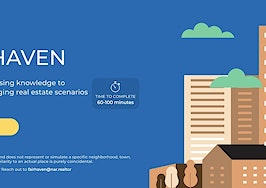This article series is largely taken from How to Be an Anti-Racist Real Estate Pro with permission from the author.
After George Floyd’s recorded and televised murder, I (like many) was appalled, devastated and disillusioned. However, after a few months, I got wind that my area’s local association — the Atlanta Realtors Association — had started a diversity and inclusion council. Wow! I had this warm feeling that this moment would be perhaps another historic turning point in the South, particularly among Realtors.
Yes, we know that social diversification (and really, all forms of change) can be uncomfortable in the early stages. But cognitive performance, innovation and bottom lines improve in the long run, so diversity is not the dirty word some think. A true culture of diversity really can be the gravy train with the right recipe.
But a culture of diversity does not stand alone. It is actually a composite of several essential ingredients. Like your favorite recipe, if something is missing from the diversity recipe, you start to see everyone frowning and pushing away from the table in disgust.
Plus, this association is in a community where the demographics in the majority — Black, Indigenous, people of color (BIPOC) — are not proportionally represented in this association’s leadership, making a call for diversity long overdue.
Words of the day our lifetime
Before continuing this story, let’s define some key terms according to my book learnings from the University of Michigan. (Go Blue! Hail Yes!) Notably, these terms are in order of importance and effectiveness in creating a culture of diversity that’s not sheer pandemonium:
- Growth mindset: Yes, we get better with time like fine wine here, aka when we transform the meaning of effort and difficulty, people can learn and improve here.
- Inclusion: Yes, we are all one of the “cool kids” here, aka people feel a sense of belonging and can express themselves here.
- Diversity: Yes, our doors are open, and glass ceilings don’t exist here. Meaning, any difference that can make a difference is welcomed here, including but not limited to race, ethnicity, nationality, educational attainment, tertiary institution, professional expertise, tenure, age, disability and health status, sexual orientation, family status, career and parental status, employment status (full time, part-time, flexible working), immigration status, faith, veteran status, English proficiency, languages spoken, etc.
- Equity: Yes, each person can eat as much or as little as needed from our buffet, aka fairness and justice in structures and systems.
Importantly, notice that diversity is most effective as an organizational objective after a mindset shift from fixed (nothing will change: old dogs can’t learn new tricks, so why bother?) to growth (we get better with time like a fine wine) has occurred.
Diversity also comes after there is a genuine cultural transformation of belonging that prioritizes everyone being seen and heard as one’s authentic self (instead of conformity for the sake of uniformity). In short, diversity before inclusion says: Let the revolving door commence, and get ready for a sky-high turnover rate of dynamic members.
Last but not least, equity is the anchor of this relay team or the icing on the cake (to stay with my recipe analogy). A willingness to grow, the inclusion of all voices, and a diversity of experiences, identities and views are prerequisites to catching areas that are lopsided to faithfully maximize institutional equity (fairness and justice).
It takes this full recipe for diversity to stop being a seemingly ill-advised, dirty word that instead our groups embrace, eat and hopefully, crave seconds.
“Diversity invites people to the table, but inclusion empowers your voice to be heard while you’re at the table,” Terence Lester, diversity scholar and minister, said. “Diversity without inclusion is shallow marketing. I do not wish to sit at any tables that want my skin for marketing but not my voice for truth and perspective.”

Since this order of lifelong key terms is vital, see if you can catch where it is lacking in the ensuing story.
How it started
For the first two meetings with Atlanta Realtors Association’s diversity council, I excitedly signed into Zoom, ready to meet with this newly minted council. This diverse group consisted of real estate pros with professional-level experience in and passion for justice, equity, diversity and inclusion (J.E.D.I.) work. Yes, I secretly cheered to myself because it felt like a new day was indeed dawning.
During the initial meetings, I noticed that psychological safety was lacking due to the tone and “power over” stance that was taken by some. Conventional wisdom affirms that with a team of volunteers, you catch more flies with honey than with vinegar, as my fellow Southerners will coo. Thus, expressing “power with” in an emotionally intelligent way is critical to maintaining the momentum volunteers crave and thrive from when engaged.
Which of our key terms was lacking or out of order?
Being the type of person I am, I spoke up outside of the meeting to not add any further injury to the group’s enthusiasm. I was heard by the association’s staff and the council chair. Yes! A good faith showing that the quest for belonging and expressing ourselves (inclusion) and fairness (equity) was likely legit.
How it’s going
Cue horror movie music. This month, at the start of Black History Month (which for me meant my hopes were soaring high), the council met again. This time, the meeting had more than those who had self-proclaimed a commitment to J.E.D.I. work.
This time, the meeting included representatives (mostly the vice chairs, mostly men and mostly white) from other committees who did not explicitly share nor deny their enthusiasm with J.E.D.I. efforts. Rather, they shared that their attendance was part of a new responsibility to sit in on this council.
It’s important to note here that J.E.D.I. work is most effective — creating the desired, productive climate — when it is compelling, not mandatory. I’m sure you can likely relate.
How do you feel, and what are the results when you want to do something versus when you are being told to do it (“voluntold” is what we call it in the nonprofit sector)? The latter scenario usually does not go as well as the former. Cue horror movie music getting louder.
During this Zoom video meeting, genuine concerns were raised surrounding how the association would implement J.E.D.I. initiatives. For example, a point was raised on how saying a Christian prayer at the start of meetings excludes those of other faiths.
After about 30 to 40 minutes of dialogue, one of the new attendees interjected. “How do we know that this is even an issue?” expressed the white male regarding diversity and inclusion. Of the other new attendees present, there were several head nods and “mm-hmms” that I noticed.
Did you notice the metacommunication? Which of our key terms was lacking or out of order?
Let’s pause for the cause. Have you ever poured your heart out and shared an experience that either happened to you or someone you know only to have the person you thought was listening say, “Huh? What did you say?” How did that make you feel?
That feeling describes how this meeting at that moment felt to me. It would have been one thing to inquire about the state of the association at the start of our group discussion before anyone had shared their experiences.
But to hear the concerns of differing religions, races, genders and sexual orientations for 30 to 40 minutes, and then ask if there is even a problem, undermines our earlier definitions of a growth mindset, diversity, equity and inclusion.
Here is how this metacommunication can be narrated: This new attendee’s question — even if unintentionally — ignored and erased each of the voices that just spoke for 30 to 40 minutes, rendering them invisible.
This new attendee’s question revealed he was (or is) having a different experience than others and was unable to empathetically step into their shoes after 30 to 40 minutes of dialogue.
This new attendee’s question felt dismissive to both the experiences and needs of the council members and the members within this local association for whom the council members were speaking on behalf for 30 to 40 minutes.
This new attendee’s question ultimately revealed a life of not having to consciously navigate all of the aforementioned challenges and thereby, not having to live a life consumed with their implications or finding methods to mitigate them like those who spoke for 30 to 40 minutes.
All in all, this new attendee’s question embodied a living, breathing, real-time example of why this particular local association is not yet (it still can be) a beacon of belonging and why robust J.E.D.I. work is essential.
To add fuel to this inferno, this local association had previously conducted membership focus groups, surveying those who did not feel a sense of belonging among the association. This information is also available, making such a question — again, with anecdotes and research data accessible — feel like a slap in the face of diversity and inclusion, which this council was designed to champion. It is literally in the name.
Conversely, how can our association (and perhaps in your case, your realty firm) leadership begin to be J.E.D.I. metacommunicators?
As Terence Lester said, “Growing in diversity and inclusion means that you learn to listen to what people have to say, that are different from you, with the filter, ‘They are speaking from an experience and perspective that is not my own.'”
In spite of all of that, as a trained J.E.D.I. worker, I wanted to tap into my empathy muscles for the new attendees: I understand how if you are currently happily in love, you don’t quite get what’s going on with those who aren’t experiencing the same degree of euphoric amore.
So, I bit the bait. I spoke up and, due to a lack of time, shared just one diminishing and exclusionary experience that I personally had as a Black person and as a woman during one of my times as a committee chair within this particular association.
This was at the end of the meeting. I received a few direct messages in the Zoom chat from the original members thanking me for being vulnerable. Then, it was time to hop off. I felt heard but perhaps not empathetically understood based on the number of furrowed brows of some of the new attendees.
Two days later, I heard from the council’s chair, a Black woman who had been awarded by this association just weeks before the Five Star Circle of Service Award (one of its highest honors to bestow). She shared that she had decided to step down (cue the revolving door). “What? Why?” I cried out as if the knife in the horror movie had been plunged into my unsuspecting and naïve back.
To sum it up, she tells me that the new attendees (specifically the one who questioned if a lack of diversity and inclusion are even problems) reported the meeting. From there, the association conveyed to the chairwoman that these meetings were really just to execute the preset agenda already decided upon by the board of directors. In essence, this attempt at a discreet rebuke amounted to sit still and make us look pretty.
Which of our key terms was lacking or out of order?
I exhaled deeply while sadness enveloped me, hearing and acknowledging these words. “Is this really happening? Is this council just for show? Why do they have us wasting our time in a pandemic if they don’t really want our input?” I pondered.
Cue the crescendo of the horror music.
‘It was all a dream, I used to read Word Up! Magazine’
One of the written, association-approved tenets of this council is “to continually review the Association for systemic racism and discrimination issues that hold back, and/or discourage diverse leadership and membership.” That’s the stated intent, but the actual impact is far from this, particularly when this very council’s input was being discouraged.

Well, how does this review properly happen if the council is told, in so many words, to just do as you’re told and to be seen not heard? (Sorry if those statements trigger any of your inner child wounds.) You probably know the answer to that — it does not happen. Instead, the status quo continues. This is fake inclusion aka tokenism.
On its face, the association can say: Look at us. We are so committed to diversity and inclusion that we have a council so named. But if you whip out a magnifying glass, it is glaringly obvious that this diversity and inclusion council as it stands today is in name only. The real discussions will still be had by only the few in the club that frankly have ignored the depth of marginalized voices, both anecdotally and from research.
Stephanie Creary, Wharton management professor, said, “… there is a wide chasm separating those organizations doing DEI work and those that are actually valuing the DEI work being done.”
Continually. Review. Discourage. Diverse. Leadership. Currently, these are just empty words on a webpage.
I was extremely disappointed. I did not knowingly sign up for and will not placate this game of charades. I am calling it out. Because with J.E.D.I. work, we have to cultivate a culture of intervention and accountability. Gone should be the days to go along just to get along when the impact is wrong.
Stay tuned for part two of this two-part series with suggested remedies I have developed from my “fancy book learnings” and J.E.D.I. work.
Download today your complimentary (aka no fee but for a limited time, so hurry) copy of my new book, How to Be an Anti-Racist Real Estate Pro. Here’s to your success! #LearnWithDrLee
Lee Davenport is a licensed real estate broker, trainer and coach. Follow her on YouTube, or visit her website.













